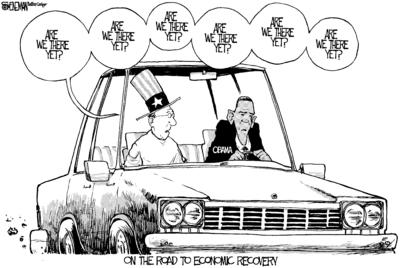- MENU
- HOME
- SEARCH
- VIDEOS
- WORLD
- MAIN
- AFRICA
- ASIA
- BALKANS
- EUROPE
- LATIN AMERICA
- MIDDLE EAST
- United Kingdom
- United States
- Argentina
- Australia
- Austria
- Benelux
- Brazil
- Canada
- China
- France
- Germany
- Greece
- Hungary
- India
- Indonesia
- Ireland
- Israel
- Italy
- Japan
- Korea
- Mexico
- New Zealand
- Pakistan
- Philippines
- Poland
- Russia
- South Africa
- Spain
- Taiwan
- Turkey
- USA
- BUSINESS
- WEALTH
- STOCKS
- TECH
- HEALTH
- LIFESTYLE
- ENTERTAINMENT
- SPORTS
- RSS
- iHaveNet.com: Economy
by Paul A. Samuelson

Legend tells of the boy who often cried "wolf" when in fact there was no wolf. It involves the case where the boy cried "wolf" when indeed there was a ferocious wolf, but no one had paid attention.
Ever since the global meltdown began in 2007, Wall Street pundits and government officials have proclaimed cheery optimism that meaningful global recovery will occur by the second half of 2009, or the first quarter of 2010. So, as in an earlier time, they're telling us we have nothing to fear except fear itself.
Well, we have now entered 2009's second half.
Yes, and unemployment is still rising. So are bankruptcies and mortgage foreclosures.
Despite the admirable rescue operations of the Obama team, the
Unemployment will worsen still, and shortfalls in the GDP growth rate will persist.
It is rational for a rescued bank to be afraid to enter into risky lending. (In serious recession times, almost all ventures seem risky to rational bankers!) Why can't orthodox central bank operations reverse accelerating recessions? Early on official shortest-term assets are given yields that approximate zero. At zero interest rates, everyone freezes up and becomes a hoarder.
Macroeconomists taught in the 1970s and 1980s at elite
When a few of us, as far back as spring of 2007, warned that meaningful recovery might be delayed by years, we were only a lunatic minority.
Yes, Japan could experience a "lost decade;" but academic financial engineers had, for the West, allegedly forged new tools to measure risk and to enable both the spread of it and the control of it. No "lost decades" for us smart guys.
A pretty fable.
Yes, those financial engineering tools, invented at the likes of
Instead of controlling riskiness, the new tools -- swaps, puts and calls, securitized packets of mortgage loans -- under President Bush's form of unregulated financial investment, did in fact kill off all transparency and did tempt to dangerous hyper-leveraging.
Result: an ultra-fragile financial system, prone to the global collapses and meltdowns seen in 2007-2009.
President Obama's resourceful Treasury secretary, Timothy Geithner, announces that the rescue is already working and with a little patience we can expect imminent recovery.
He errs. The rescue of needed new sustained Main Street spending has hardly begun. Without such, as the New Deal learned in the 1930s, recovery is impossible.
Yes, had there not been the massive Geithner-Bernanke rescue moves, by this time blood might be flowing in America's city streets. But has any member of Obama's crack economic team spoken day and night about the need to send to Main Street money for sustained spending and re-spending? No.
China, a one-party despotic state, by piling on new deficit spending will, paradoxically, beat the rest of us to meaningful macro recovery
When as a teenager I entered graduate study at the Chicago Midway in 1932, it was the worst time of the post-1929 depression. Republican President Herbert Hoover and his billionaire Treasury secretary, Andrew Mellon, by their paralyzed inactivism, wasted almost two years after the 1929 Wall Street crash, a long enough delay to lead to self-generating bank failures and exploding unemployment.
Today's macro scholars were poorly prepared to avoid post-2006 meltdowns.
While they still prattled mostly about transparency and inflation targeting, they didn't notice how Rome was beginning to burn.
Their textbooks, whether introductory or advanced macroeconomics, did not teach about "liquidity traps" or "paradoxes of thrift," whereby the attempt of people and businesses to save more only served to kill off rather than augment Main Street spending.
It is giving sustained funds to ready spenders that counts most.
Now, in the second half of 2009, it is too late to begin to spend on shovel-ready projects. States and municipalities need help to meet their budget needs, and they take time to achieve legislative agreement on how to deal with deficits and how to spend government stimulus funds.
Suffering states will spend whatever they are given
So discount those rosy assurances of meaningful recovery a few months from now.
The late Charles Kindleberger, expert on manias and financial crashes, reiterated the Victorian Walter Bagehot's insistence that every capitalist system needs a "lender of last resort." If alive today, Professor Kindleberger would insist that it needs also a "spender of last resort": government.
Republican members of Congress do not understand these ABCs. Nor do a few of the Democrats in Congress. Time delays are crucially lethal once a recession is becoming self-generating in the chicken-egg-chicken fashion.
Only an Obama has the charisma and popularity to insist on meaningful needed new and sustained deficit spending. Yes, deficit spending.
It took all of Franklin Roosevelt's guile and eloquence to push things and maintain the New Deal recovery. Abhorrent dictator Adolf Hitler, bent on conducting a future war of revenge, used similar deficit spending to restore Germany to full employment by 1939.
May democracies in the 21st century quickly achieve the compromises needed to restore economic sanity.
© Tribune Media Services
WORLD | AFRICA | ASIA | EUROPE | LATIN AMERICA | MIDDLE EAST | UNITED STATES | ECONOMY | EDUCATION | ENVIRONMENT | FOREIGN POLICY | POLITICS
Early Economic Recovery: Fiction or Fact - Paul A. Samuelson